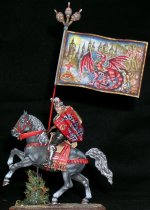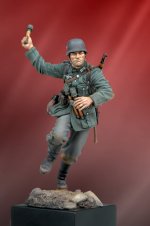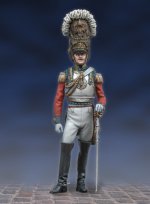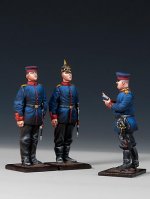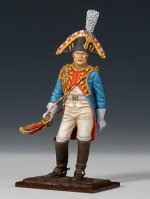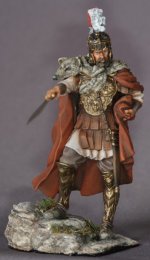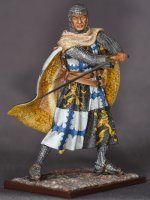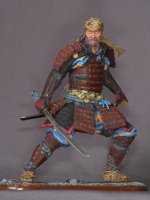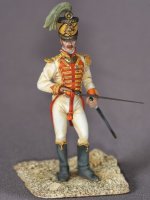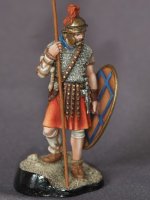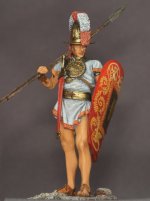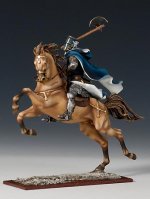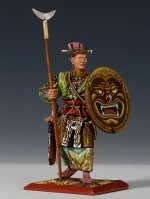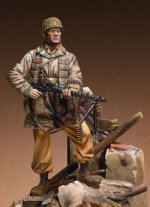You are using an out of date browser. It may not display this or other websites correctly.
You should upgrade or use an alternative browser.
You should upgrade or use an alternative browser.
Napoleonic figures (1 Viewer)
- Thread starter Combat
- Start date
Pat clued me in to this figure a while back. I've been toying with buying it ever since. Vlad Dracula:
Hi Combat,
That figure does tend to get into your blood, doesn't it?
Thanks for posting that great picture!
Warmest personal regards,
Pat
kilted vampire
Lieutenant Colonel
- Joined
- Mar 2, 2006
- Messages
- 7,900
Did zome von zay Drakola???? MUAHahahhahahhaaaaaaaaaaaaaaa
I really like the crazed look in the eye of Dracula's horse. A nice mix of the historical and supernatural legend. It's on my list Pat - along with john jenkins, Figarti V2....
Hi Combat,
I clearly understand about "the list." My list is way, way too long!
Warmest personal regards,
Pat
Combat
Brigadier General
- Joined
- Jun 10, 2005
- Messages
- 11,007
Andrea miniatures has some new releases. If anyone has done business with them - particularly in arranging top quality painting - I would appreciate any feedback on how it worked out:
Attachments
Harrytheheid
Banned
- Joined
- Apr 19, 2007
- Messages
- 4,672
A nice example as to why the Russian figures are the best in the world:
Sheesh.....no argument there. Does Canadian Samurai know about these figurines?
Happy New Year Combat
Cheers
H
Combat
Brigadier General
- Joined
- Jun 10, 2005
- Messages
- 11,007
Nice example of how additional historical info may increase collector interest in a particular figure:
History: The idea for the realisation of this figurine comes from the statue of the “warrior of Capestrano” which was found in Abbruzzo ( L’Aquila ) and is now kept in the National Archaeological Museum of Chieti. The armour is typical of the italic warriors living in the Apennines area. The Oscan-Sabellas language as well as the Sannitic language were common to these populations that historically had to withstand the Roman expansion between the VI and the III century b.C. The chest is protected by the kardiophylax (literally hart protector) a bronze disc (front and back) often showing an episema which is the mythogical representation of a doubled protome animal. The anchoring system is made out of both bronze and leather straps, with an odd support for the cross hilted sword, which has the shape of a lengthened willow leaf, whose sheath is also equipped with a scabbard for a dagger. An extra weapon could sometime be the straight axe slipped through the belt and mainly used as a sign of distinction for leaders. The abdomen is partially protected by a belt made out of bronze. The figurine wears a collar (turquis) which is also made out of bronze. The helmet is made out of bronze and is embellished by a multi coloured horsehair crest. The shield which could vary in shapes was made out of wood laminated with leather and often painted. The bronze umbo at a later date was made out of iron. Other typical weapons were, the javelin (pila) used during the initial skirmishes when the enemy was still distant, and the lance (hasta) used for close combat prior to utilize the dagger (or the sword). The boots are in leather. The tunic tightened at the waist by the belt is in pastel whitish colour or brown or red. Decorations of the rims could be painted in Greek fashion or in any other geometrical pattern.
History: The idea for the realisation of this figurine comes from the statue of the “warrior of Capestrano” which was found in Abbruzzo ( L’Aquila ) and is now kept in the National Archaeological Museum of Chieti. The armour is typical of the italic warriors living in the Apennines area. The Oscan-Sabellas language as well as the Sannitic language were common to these populations that historically had to withstand the Roman expansion between the VI and the III century b.C. The chest is protected by the kardiophylax (literally hart protector) a bronze disc (front and back) often showing an episema which is the mythogical representation of a doubled protome animal. The anchoring system is made out of both bronze and leather straps, with an odd support for the cross hilted sword, which has the shape of a lengthened willow leaf, whose sheath is also equipped with a scabbard for a dagger. An extra weapon could sometime be the straight axe slipped through the belt and mainly used as a sign of distinction for leaders. The abdomen is partially protected by a belt made out of bronze. The figurine wears a collar (turquis) which is also made out of bronze. The helmet is made out of bronze and is embellished by a multi coloured horsehair crest. The shield which could vary in shapes was made out of wood laminated with leather and often painted. The bronze umbo at a later date was made out of iron. Other typical weapons were, the javelin (pila) used during the initial skirmishes when the enemy was still distant, and the lance (hasta) used for close combat prior to utilize the dagger (or the sword). The boots are in leather. The tunic tightened at the waist by the belt is in pastel whitish colour or brown or red. Decorations of the rims could be painted in Greek fashion or in any other geometrical pattern.
Attachments
Wraith
Major
- Joined
- Aug 26, 2006
- Messages
- 6,777
You must return here with a shrubbery... or else you will never
pass through this wood... alive.
Been too long without a quote.
Harrytheheid
Banned
- Joined
- Apr 19, 2007
- Messages
- 4,672
New Andrea 90mm figure - Fallschimjäger. Monte Cassino, 1944:
Combat, do you paint these yourself or is this how they come from Andrea..??
Regards
H
Combat
Brigadier General
- Joined
- Jun 10, 2005
- Messages
- 11,007
Combat, do you paint these yourself or is this how they come from Andrea..??
Regards
H
H-
You can order either painted or unpainted. Of course painted costs a lot more. At least one member here has ordered unpainted and then arranged for a russian master painter to finish it.
http://www.andrea-miniatures.com/esp/Index.html
Users who are viewing this thread
Total: 2 (members: 0, guests: 2)


